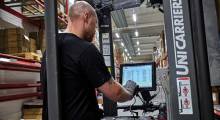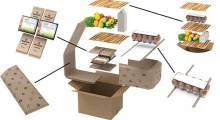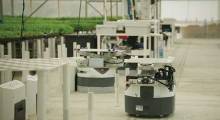You’ve heard the old saw about a better mouse trap and the path to your door. Here’s the materials handling version: build a better pallet, and industry will beat a path to your door.
“Do you think that’s true?” Young Lee asked me last week.
I assured him I do. Lee is the executive director of AL Pallet USA. While the company has been in existence since 2002 in Korea, AL Pallet’s aluminum pallet is a new entrant to the North American pallet market. To kick things off, AL Pallet is exhibiting at ProMat at booth 4547.
Lee and his colleagues believe they have built the better mouse trap with a patented design that looks good and carries a relatively heavy load with a light pallet. “Our one way pallet weighs about 4.8 kilograms, or 10 to 11 pounds,” says Lee.
AL Pallet has developed a unique manufacturing process that allows it to manufacture to any specification. The pallet does not require fumigation or heat treatment to meet export pallet requirements and it is non-magnetic, so it doesn’t collect dust. Last, it has a scrap value once it has reached the end of its usable life, which Lee estimates is about 20% of the value of the original pallet.
Since they are more expensive than wooden pallets – prices vary, but Lee estimates the cost of a typical one-way pallet at $35 - aluminum pallets are a niche product. In Korea, AL Pallet has successfully targeted the high tech electronics customers, including Samsung, LGE Mobile, AT&T and Nokia TMC.
Each of those customers manufactures a high value product that is shipped by air freight. For them, there are at least three selling points. One is that the pallet works well in a clean manufacturing environment. More importantly, its light weight saves on air freight costs compared to heavier wood or even plastic pallets. Last, in addition to aluminum pallets, AL Pallet produces an aluminum pallet and box for more secure shipments. Given the retail cost of a cell phone, any reduction in shrinkage goes right to the bottom line.
For manufacturers interested in green logistics, AL Pallet touts a study conducted by the Korea Environment Industry Institute on the carbon emission coefficients by the different basic materials. The study looked at the amount of carbon emissions produced by a pallet that was manufactured in Korea and then shipped to Dallas, where it is discarded after one use. The aluminum pallet creates 62.43 kg CO2, compared to 160.96 kg CO2 for wood and 179.47 kg CO2.
How those figures will compare to pallets produced in North America and shipped to Europe or Asia would require a different calculation. However, those are messages that Lee believes will resonate with North American customers who ship high value products by air freight or who have captive pallet systems.
“We believe we’re ready to penetrate the US market,” says Lee. “We know there are numerous products produced in North America that are shipped globally and there are manufacturers with closed loop systems.”
For now, the pallets will be produced in Korea and shipped to the US, which means order quantities of 400 to 500 pallets. “Once we have enough volume, we will manufacture in the US, which will bring down the cost of manufacturing,” he says.
With luck, the materials handling world will beat a path to Lee’s door.
Pallets move Modern’s readers
From wood to plastic to pallet pools, our readers tell us what’s important in pallets.
Pallets 101: Iron man, or what you need to know about metal pallets








